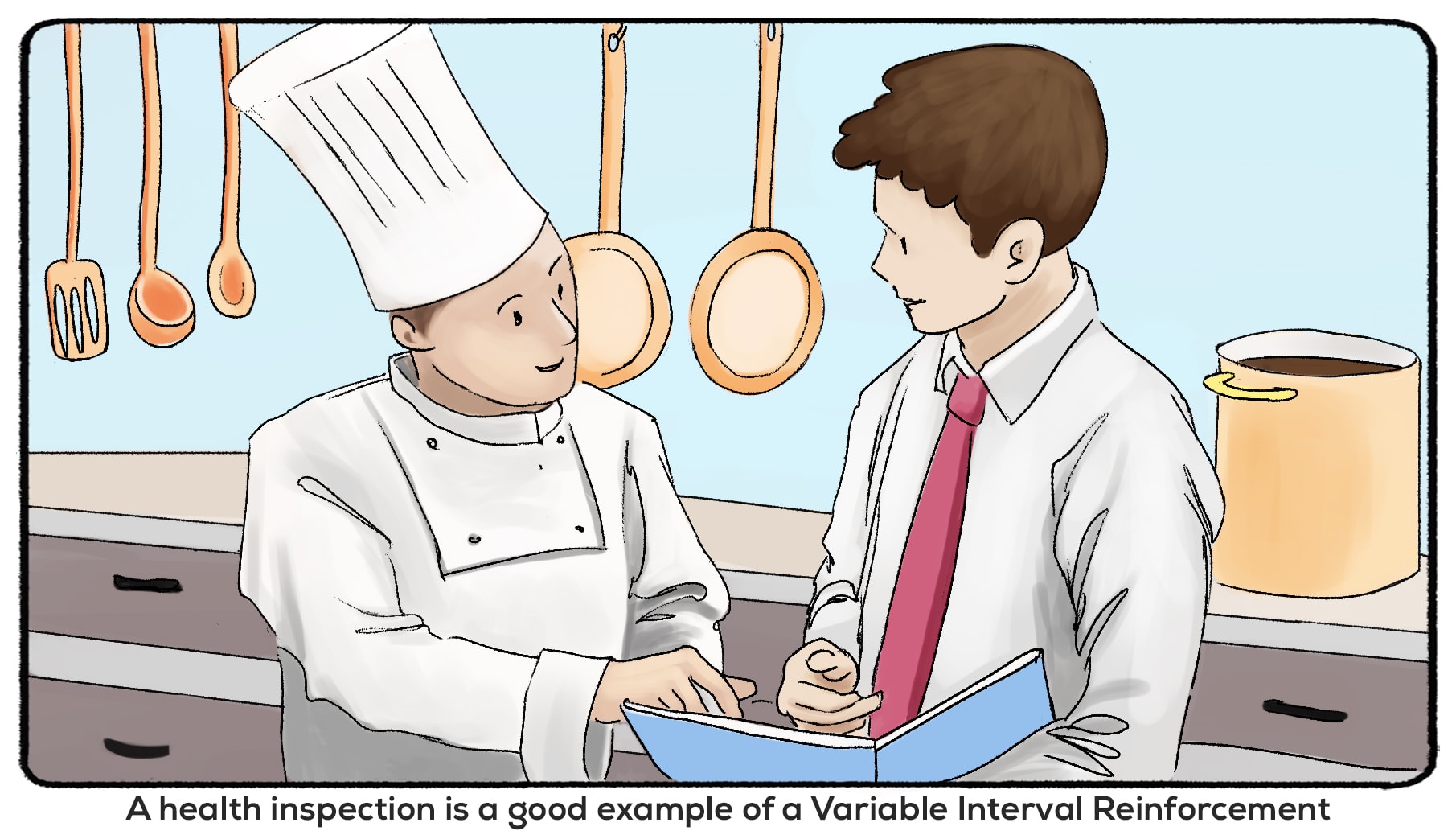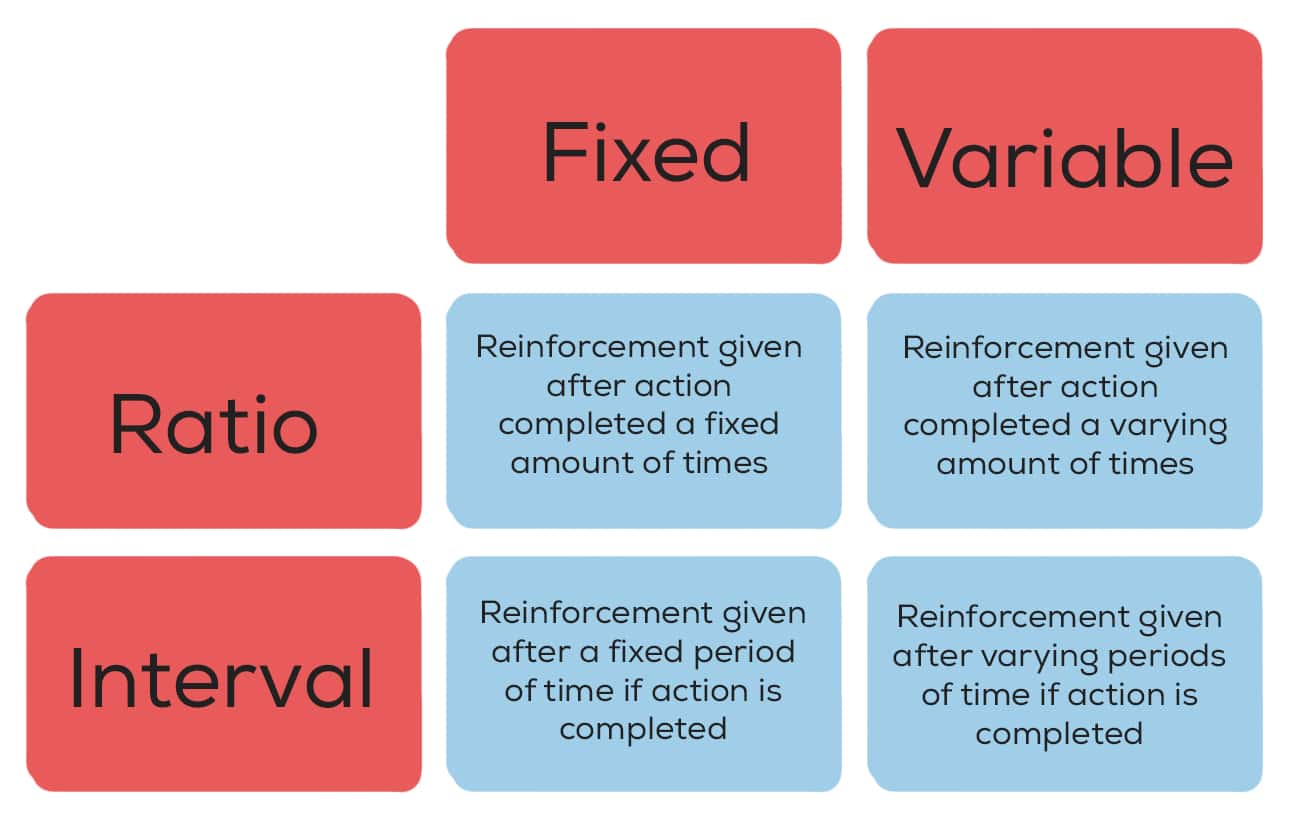It’s always nice to be recognized for good work, even if that recognition or reward happens randomly. Some people appreciate receiving praise or rewards only randomly. Accountability in the form of surprise check-ins keeps many people on their toes, always working to the best of their ability.
This isn’t the only way to encourage good behavior, but health inspections, pop quizzes, and other forms of variable interval reinforcement can work. Whether you are trying to lock in a new habit or motivate your students to study every night, this reinforcement schedule is one of a handful that is available for your use.
Curious about variable interval reinforcement and other ways to encourage behavior? Keep reading!
What is Variable Interval Reinforcement?
Variable interval reinforcement is a schedule in which reinforcements are distributed at varying intervals, depending on whether or not the desired behavior has been performed. These intervals may be completely random or within a range of times, but they are not fixed.
Who “Discovered” Variable Interval Reinforcement?
B.F. Skinner frequently hailed as the "father of operant conditioning," made groundbreaking contributions in developing the concept of reinforcement schedules, including variable interval reinforcement. In his experiments, typically conducted on animals within a controlled environment known as the "Skinner box," he observed how organisms responded to reinforcements delivered at unpredictable intervals. Skinner's insights into variable interval reinforcement demonstrated that such a schedule can lead to steady, consistent response rates. While his primary work was on animals, the principles he unearthed are universally applicable. They have since been applied to human behavior and effectively implemented in a wide range of contexts globally.
What Are Reinforcements?
If you're not recently acquainted with the nuances of behaviorism, let's delve into a brief overview. At the heart of behaviorism is the principle that reinforcements are instrumental in strengthening a conditioned response. For instance, consider a scenario where you aim to condition a child to form a habit of making their bed immediately upon waking. While it's commendable if they can consistently adopt this behavior on their own, using reinforcement can significantly enhance the frequency and consistency of this behavior.
However, it's crucial to understand that not all reinforcements are tangible rewards. Positive reinforcements pertain to adding a favorable stimulus to increase the likelihood of a behavior. Examples include giving a child a candy bar or granting them laptop access due to their desired behavior.
On the other hand, negative reinforcement revolves around removing an aversive stimulus to increase the likelihood of a behavior. It doesn't mean punishing the subject. For example, silencing a persistent high-pitched noise or removing an uncomfortable harness after an animal performs a desired action both fall under negative reinforcement. Removing the aversive condition (noise or harness) encourages the behavior to be repeated.
For psychologists, this intricate interplay between behavior and reinforcements is fundamental to operant conditioning. This methodology involves intentionally using reinforcements or punishments to promote or deter certain behaviors. Among the various strategies available in operant conditioning, the variable interval reinforcement schedule stands as a prominent technique.
Variable Interval Reinforcement vs. Continuous Reinforcement
Variable interval reinforcement is a partial schedule of reinforcement instead of a continuous set of reinforcement. Not every behavior is immediately reinforced. A kid could spend their whole day choosing to study instead of playing video games, but they will not be rewarded for every minute or hour they study. Reinforcements are given seemingly at random.
Real-Life Examples of Variable Interval Reinforcement
Not everyone who schedules this operant conditioning type knows they are operating on a variable interval reinforcement schedule, but it works just the same. Some of the most commonly used forms of variable interval reinforcement include:
- Health inspections
- Pop quizzes
- Speed traps or DUI checkpoints
- Verbal praise
- Random gifts
1) Health Inspections
One classic example of variable interval reinforcement is having a health inspector or secret shopper enter a workplace. Store employees or managers may not know when someone is coming in to inspect the store, although they may know it’s happening once a quarter or twice a year. The secret shopper goes into the business, interacts with employees, and sends a report back about their experience. If the employees did their job well, they might get a bonus or just congratulations from managers.

2) Pop Quizzes
Another classic example of variable interval reinforcement is a pop quiz. Teachers won’t tell students when these pop quizzes will happen, so students are expected to pay attention and study throughout the week, month, or semester. If the student has displayed this good behavior, they will likely get an A on their quiz, and their grade will go up.
3) Speed traps and DUI checkpoints
Not all reinforcements have to be a reward. Things may also be removed from a situation to encourage certain behaviors. One example is speed traps and DUI checkpoints. These “traps” are set up at various times, dates, and places along the highway. The stress of running into one of these traps always lingers over drivers, especially in states where these traps are common. But if you aren’t speeding or encounter a checkpoint with a blood alcohol content below the legal limit (.08,) that stress will be removed, and you will be free to go.
4) Verbal Praise
You may be able to think about a time when your parent walked into your room, saw you studying for school instead of goofing off, and told you they were proud of you. That praise feels great! Of course, no parent offers this praise every time they see their child doing well; they might be too tired or distracted to do so. Verbal praise likely comes at varying intervals. It’s still a form of variable interval reinforcement, even if there is less intention behind it.

5) Random Gifts
Maybe your parents decided one day that because you’ve been practicing the violin a lot, they will buy you a ticket to a concert you’ve been wanting to attend. They can’t buy you a concert ticket every time you play the violin, or they will go into debt! Small reinforcements like this likely encouraged you to continue that good behavior, even though you don’t know exactly when you’ll get another “treat” or reward like the ones you’ve received in the past.
Does Variable Interval Reinforcement Work?
Psychologists have found that this variable interval reinforcement schedule can increase the likelihood that a behavior will be formed, especially when reinforcements are frequent. This reinforcement schedule definitely keeps subjects on their toes! However, this is more effective for humans than animals. Animals may not connect a reinforcement to behavior that happened one week, one day, or even two minutes prior.
Running into a DUI checkpoint is a strong motivator to stay sober or have a designated driver. Random health inspector visits are a strong motivator to keep your restaurant clean. If you know that you will run into a speed trap at some point during the week, you are more likely to drive the limit than you would if speed traps were only set once a year. However, distributing treats to dogs at random times is not likely to be effective unless the dog can immediately connect the treat with good behavior. Dogs don’t have long attention spans, so good luck with that!
Even in humans, there is a brief dip in performance once the behavior is reinforced; overall, the rate of performing the behavior remains steady.
What Is the “Best” Reinforcement Schedule?
Subjects are most likely to perform a behavior if reinforcement is administered every time, but continuous reinforcement is not always possible or practical. Costs, time, and other factors determine how often reinforcements can and will be distributed. The variable-ratio is a pretty solid reinforcement schedule of the partial reinforcement schedules. (No wonder slot machines are so popular!) Factors like the reinforcement, the conditioned response, and the ratio of intervals may also affect how likely the subject will perform a behavior. If you only give a child a small amount of allowance once a year for making their bed, they are not likely to make it every day. If that allowance becomes a trip to an amusement park, the child may be more motivated.
How to Use Variable Interval Reinforcement In Training
Consider a variable interval reinforcement if you want to encourage your child to do their homework or encourage your employees to greet every customer. Pick a random date of the year to check up on your “subjects” and see if they are performing the behaviors you expect. If they are, provide a reward that is memorable and motivating.
For example, if you want your child to keep their room clean, let them know that you will enforce “surprise inspections” of their room. Tell them what reinforcement you will share ahead of time. Allowance? A new video game? The latest iPhone? When you share the reinforcement, your child will know the stakes and be more motivated to clean their room. Pick a number at random - maybe six - and remind yourself to check on their room in six days. Don’t wait too long!
You may have a harder time setting this schedule because you can’t surprise yourself, but this is where accountability or a trainer can come in handy. Tell them about a variable interval reinforcement and ask them to incorporate it into your meetings or training sessions. Share the reinforcements that will motivate you to stick to your goals. You might find yourself behaving better than you did before!
Other Schedules of Reinforcement
Does reinforcement have to be distributed at various intervals? Not necessarily! Psychologists have identified variable interval reinforcement as one of four main partial schedules of reinforcement. The other partial reinforcement schedules are:
- Fixed Interval Reinforcement
- Fixed Ratio Reinforcement
- Variable Ratio Reinforcement

Fixed Interval Reinforcement
When reinforcements are distributed simultaneously, on the same day, a week, or after a fixed passage of time, psychologists call it a “fixed interval reinforcement.” One example of fixed interval reinforcement is offering an allowance at the end of the week if a child has completed their chores. Even if there is just one chore on the list and the child completes it one hour before “time is up,” they will still receive the reinforcement.
Fixed Ratio Reinforcement
Schedules may also rely on how many times the response is recorded. If you give out a reward once your child logs five hours of studying, for example, you are working on a fixed-ratio reinforcement schedule. The most common example of this type of reinforcement is reward cards at coffee shops or other retail locations. Buy nine coffees, get one free!
Variable Ratio Reinforcement
You can also go by a variable ratio reinforcement schedule. This type of schedule distributes reinforcements at various ratios. Sometimes, the reinforcement is given after two of the same conditioned responses are performed. Other times, you have to perform the response 100 times to receive the reinforcement. Slot machines are a great example of variable ratio reinforcement. Gamblers are encouraged to keep pulling the lever, hoping that the reinforcement will be distributed next time.
